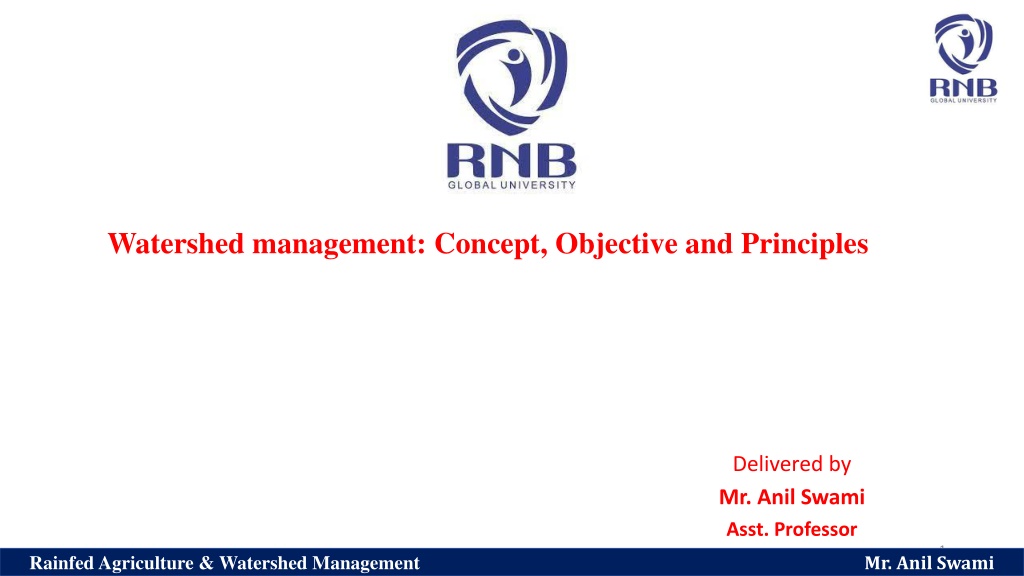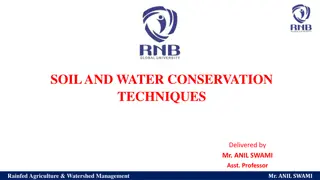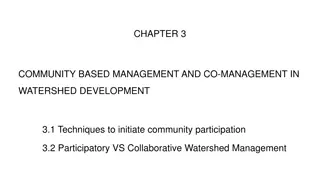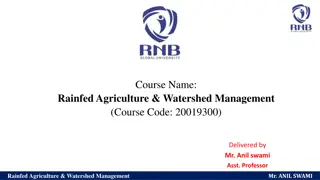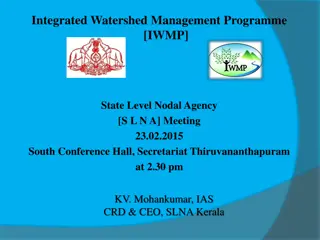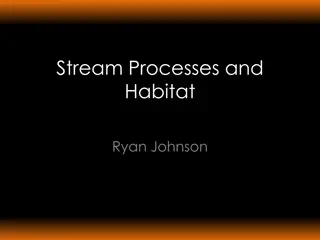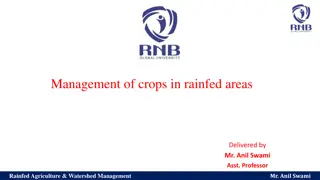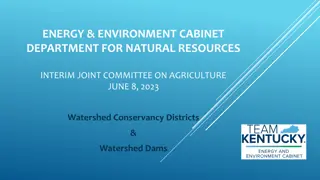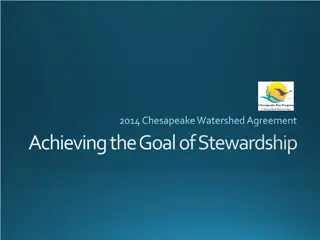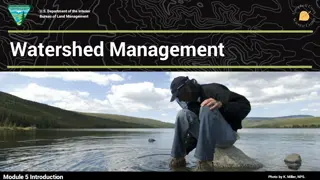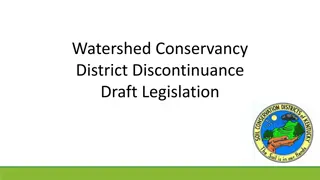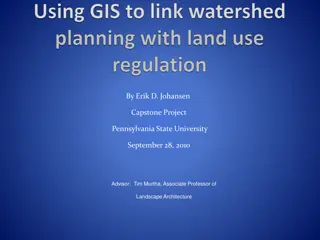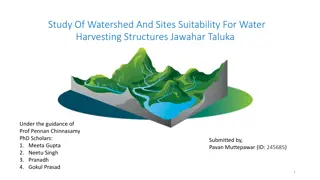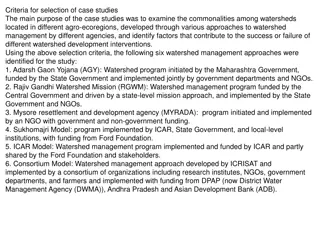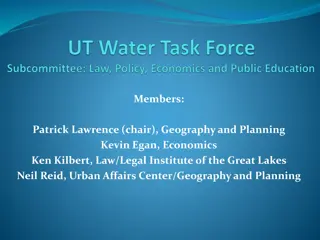Watershed Management: Concepts, Objectives, and Principles Explained by Mr. Anil Swami
Watershed management involves the rational use of land, water, and vegetation resources to optimize production while minimizing risks. Mr. Anil Swami emphasizes the importance of understanding soil and climate conditions, implementing water harvesting techniques, and practicing contingent crop planning in rainfed areas. The integration of technologies within natural boundaries enhances sustainable resource utilization for the benefit of farmers and society as a whole.
Uploaded on Oct 05, 2024 | 0 Views
Download Presentation

Please find below an Image/Link to download the presentation.
The content on the website is provided AS IS for your information and personal use only. It may not be sold, licensed, or shared on other websites without obtaining consent from the author. Download presentation by click this link. If you encounter any issues during the download, it is possible that the publisher has removed the file from their server.
E N D
Presentation Transcript
Watershed management: Concept, Objective and Principles Delivered by Mr. Anil Swami Asst. Professor 1 Mr. Anil Swami Mr. Anil Swami Rainfed Agriculture & Watershed Management Rainfed Agriculture & Watershed Management
Objective:- Tell the soil and climatic conditions prevalent in rainfed areas. Interpret various water harvesting techniques and their efficient utilization. Apply contingent crop planning for aberrant weather conditions. Examine the seasonal rainfall and different types of watershed and its components. Select soil and water conservation techniques to avoid their losses. 2 Mr. Anil Swami Rainfed Agriculture & Watershed Management
Watershed Management: - Watershed management is the rational utilization of land, water and vegetation resources for optimum production with minimum hazards. It involves management of land surface and vegetation so as to conserve the soil and water for immediate use and long-term benefits for the farmers and the society as a whole. In a watershed management system having favourable topography where improved land-use practices could be introduced easily and precipitation distribution is not much uneven or erratic, such a system may be termed as well- managed. Mr. Anil Swami Rainfed Agriculture & Watershed Management
Watershed management is an integration of technologies within the natural boundaries of the drainage area for optimum development of land, water and plant recourses to meet the basic needs people in a sustained manner. Watershed management may be defined as the process of formulating and carrying out a course of action involving manipulation of natural, agricultural and human resources of a watershed to provide resources that are desired by and suitable to the watershed community, but under the condition that soil and water resources are not adversely affected. Mr. Anil Swami Rainfed Agriculture & Watershed Management
Concepts of Watershed Management: It is not that watershed concept is not known, but many times the technical aspects of the development either not well understood or are badly applied. Since, no package of practices of wade-scale application of watershed technologies exists. The intensification of land use in the traditional agricultural setting is self-defeating because it is exploitive. Mr. Anil Swami Rainfed Agriculture & Watershed Management
The present agricultural practices greatly increase runoff and soil erosion, reduce groundwater recharge, cause floods and sedimentation of reservoirs etc. As a result, the cultivated land resource base is shrinking and its productive capacity is diminishing. The management of watershed resources to produce more than one product is called multiple use concepts . Most of the development activities are closely associated with the development and use of water resources. Mr. Anil Swami Rainfed Agriculture & Watershed Management
The main aim of multiple use management should be to manage natural resources for the most beneficial combinations in present and future uses. It is not necessary that every watershed is managed for all possible natural resource products simultaneously. In the watershed concept development is not confined to agricultural land alone but covers the entire watershed area. Watershed management is a holistic development concept that encompasses land, water, agriculture, forestry and all related enterprises matters in relation to the people who inhabit the area and their socio-cultural system. Mr. Anil Swami Rainfed Agriculture & Watershed Management
Watershed management envisages not only adoption of soil and water conservation measures, but all other measures for increasing productivity, production and economic return for the farmers in the watershed area. The object of watershed management is to meet the problems of land and water use not in terms of any one measure, but on the basis that all resources are interdependent and must be considered together. Mr. Anil Swami Rainfed Agriculture & Watershed Management
Objectives of Watershed Management: There are various descriptions of the objectives of watershed management, mostly depending on the emphasis given in the proposed management programme. The main objective of its development and management is proper use of all the available recourses of watershed for optimum production with minimum hazards to natural resources. Mr. Anil Swami Rainfed Agriculture & Watershed Management
The overall objectives of a watershed management either single or in combinations are outlined as: 1. To control damaging runoff and soil erosion. 2. To protect, conserve, and improve the natural resources for efficient and sustained production. 3. To manage the watershed in order to minimize floods, droughts, landslides, etc. Mr. Anil Swami Rainfed Agriculture & Watershed Management
4. To protect and enhance water resources, reducing silting of conservation structures and conserving rainwater. 5. To increase the groundwater recharge through in-situ conservation and water harvesting structures. 6. To rehabilitate the deteriorating lands. 7. To utilize the natural local resources for improving agriculture and allied occupations so as to improve the socio-economic conditions of the beneficiaries. Mr. Anil Swami Rainfed Agriculture & Watershed Management
Principles of Watershed Management: The important principles of watershed management techniques are: 1. Utilizing the land according to its land capability classification (LCC) 2. Putting adequate vegetative cover on the soil surface for controlling soil erosion, mainly during the rainy season. 3. Conservation of maximum rainwater at the place where it falls on arable land by conservation practices. 4. Draining out excess water with safe velocity to avoid soil erosion and storing it in different rainwater harvesting structures for efficient future use. Mr. Anil Swami Rainfed Agriculture & Watershed Management
5. Preventing gully formation and putting check dams and gully plugs at suitable intervals to control soil erosion and increase groundwater recharge. 6. Safe utilization of marginal lands through alternate land use systems. 7. Maximizing productivity per unit area, per unit time and per unit water. 8. Improving sustainability of ecosystem and socio-economic status of the inhabitants. Mr. Anil Swami Rainfed Agriculture & Watershed Management
14 Mr. Anil Swami Mr. Anil Swami Rainfed Agriculture & Watershed Management Rainfed Agriculture & Watershed Management
